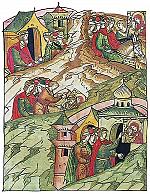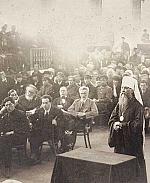Which text? Whose job? What language?

[above: Vladimir Hau, Filaret (Drozdov), 1854. Drawing.—Moscow State Historical Museum / Public domain, Wikimedia]
When a complete authorized translation of the Russian Bible was finally published in 1875, it arrived on the scene to concerns and controversy. This relatively late Synodal translation, or sinodal’ny perevod, was due partly to the fact that the Russian Orthodox Church used the Slavonic Bible liturgically. But the delay also revolved around and resulted from major disputes over authority—disputes that revealed significant fault lines in religious culture.
The most basic of these disputes arose over which sacred texts were considered authoritative. The Russian Bible Society (RBS), established in 1812 with support from the British and Foreign Bible Society, followed the lead of its Western Bible Society counterparts in utilizing the Hebrew Masoretic text, alongside the Greek Septuagint, for Old Testament translation. In doing so it drew upon the expertise of a distinguished group of academic Hebraic scholars in St. Petersburg and Moscow, notably St. Petersburg professor, archpriest, and tutor to the tsarevich, Gerasim Petrovich Pavsky (1787–1863).
This appeal to the Hebrew text effectively challenged the Septuagint, the textual foundation of the Slavonic Bible, and became the subject of bitter dispute by more conservative Russian biblical scholars—a dispute only partially resolved by placing bracketed alternative Septuagint readings in Russian at the bottom of pages in later published editions of the Synodal Old Testament.
In the case of the New Testament, the RBS’s first complete Russian-language NT (1820), as well as the first complete Synodal NT (1862), drew upon the Erasmian Greek textus receptus, an edition based on a handful of Greek texts available to sixteenth-century scholar Erasmus (see CH 145). By the nineteenth-century’s end, subsequent Greek New Testament scholarship had eclipsed this textus receptus, leading to ongoing debate among Russia’s biblical scholars in the early twentieth century.
Despite all this the RBS managed to translate and issue first editions of the New Testament, the Psalter, and the first eight books of the Old Testament (the so-called Octateuch). By the early 1820s, the success of the RBS and its modern stereotype printing establishment in St. Petersburg had attracted opposition from a growing number of conservative church hierarchs and prominent societal arbiters of traditional religious culture, including Tsar Alexander I’s own confessor, Archimandrite Foty (1792–1838). As a result Nicholas I (1825–1855) closed the RBS in 1826, accompanied by a prohibition on modern biblical translation. This forced Russian biblical translation underground for the next 30 years.
Looking to the past
This generated a second question of authority dividing religious thinkers. Who had the authority to translate and publish holy Scripture? Notable editions of Russian-language Scripture continued to circulate underground throughout the reign of Nicholas I. But when biblical translation reopened in the reign of Alexander II (1855–1881), Moscow metropolitan Filaret (Drozdov, 1782–1867) articulated the accepted understanding: the church alone had the authority to translate and publish editions of Scripture. This was waived only for Jewish Russian/Hebrew diglot (bilingual) editions of the Hebrew Bible.
Russian religious culture continued to be divided over a third problem as well: what is an authoritative language for biblical translation? The Synodal translation of the Bible—still the most widely circulated edition of Scripture in Russian to the present—represents a pre-Pushkin nineteenth-century Russian language that can lead to obscure and difficult-to-understand passages. (Alexander Pushkin [1799–1837] was a great Russian poet who is considered by many as the founder of modern Russian literature.) Nevertheless during the heavy years of Soviet religious persecution, the very “datedness” of the Synodal biblical text often attracted readers otherwise put off by the degradation, or Sovietization, of the Russian language.
These issues of authority—of base texts, of translators and publishers, and of the language employed—continue today, even in an environment in which the Synodal Bible faces competition from multiple new translations in a less heavily censored Russian religious marketplace.
By Stephen K. Batalden
[Christian History originally published this article in Christian History Issue #146 in 2023]
Stephen K. Batalden, professor of history and director of the Arizona State University Melikian Center for Russian, Eurasian, and East European Studies, and author of Russian Bible WarsNext articles
Christian History TImeline: Christ and culture in Russia
Selected events from this issue and their context. (Underlined items represent the rise to power of some major political leaders.)
the editorsSupport us
Christian History Institute (CHI) is a non-profit Pennsylvania corporation founded in 1982. Your donations support the continuation of this ministry
Donate







